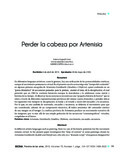Mostrar el registro sencillo del ítem
Perder la cabeza por Artemisia
| dc.creator | Zappelli Cerri, Gabrio | |
| dc.date.accessioned | 2021-07-23T20:38:28Z | |
| dc.date.available | 2021-07-23T20:38:28Z | |
| dc.date.issued | 2015 | |
| dc.identifier.citation | https://revistas.ucr.ac.cr/index.php/escena/article/view/22585 | |
| dc.identifier.issn | 1409-2522 | |
| dc.identifier.uri | https://hdl.handle.net/10669/84210 | |
| dc.description.abstract | En diferentes lenguajes artísticos, como la pintura, hay una utilización de las potencialidades cinéticas, aunque el movimiento permanezca virtual. En el presente escrito se investiga este “tiempo del contenido” en algunas pinturas escogidas de Artemisia Gentileschi (Giuditta e Oloferne), quien confiando en un “guion dramático” de secuencias pensadas para la pintura, asumió el tema de la decapitación, el cual permitió que en 1960 la corriente feminista europea la descubriera y la celebraran como mártir y heroína de su tiempo. Al observar las secuencias se reconstruye una “pequeña historia de horror” que se relata a través de diferentes representaciones pictóricas del mismo cuento dramático y permite ubicar los siguientes tres tiempos: la decapitación, la huida y el triunfo a través del encuadre y la secuencia. Por lo que, en este análisis de contenido, encuadre y secuencia, se delimita el movimiento para que sea considerado, además de un componente sintáctico, el índice semántico del contenido cinético de una imagen en el tiempo. La cinética pictórica de Artemisia produce un movimiento narrativo de las imágenes, que va más allá de una simple grabación de las secuencias “cinematográficas” virtuales, congeladas en el lienzo. | es_ES |
| dc.description.abstract | In different artistic languages such as painting, there is a use of the kinetic potential, but the movement remains virtual. In the present paper investigates this “time of content” in some paintings chosen by Artemisia Gentileschi (Judith and Holofernes), who rely on a “dramatic script” of sequences designed for painting, she took the theme of decapitation, which allowed in 1960 the European feminist movement and celebrate the discovery of a martyr and hero of his time. By observing the sequences a “little horror story” is reconstructed, which is told through different pictorial representations of the same dramatic story and it allows locating the following three stages: the decapitation, the flight and the triumph through the frame and sequence. Therefore, in this content, frame and sequences analysis delimit the movement to be considered such a syntactic component as the semantic content of kinetic rate on an image in time. The kinetics of Artemisia produces pictorial narrative motion pictures, which goes beyond a simple recording of the “film” virtual sequences frozen on the canvas. | es_ES |
| dc.language.iso | spa | es_ES |
| dc.source | ESCENA. Revista de las artes, vol. 75(1), pp.89-102 | es_ES |
| dc.subject | Artemisia Gentileschi | es_ES |
| dc.subject | Giuditta | es_ES |
| dc.subject | Oloferne | es_ES |
| dc.subject | Movimiento | es_ES |
| dc.subject | Encuadre | es_ES |
| dc.subject | Secuencia | es_ES |
| dc.subject | Judith | es_ES |
| dc.subject | Holofernes | es_ES |
| dc.subject | Movement | es_ES |
| dc.subject | Frame | es_ES |
| dc.subject | Sequence | es_ES |
| dc.title | Perder la cabeza por Artemisia | es_ES |
| dc.title.alternative | Loosing Your Head for Artemisia | es_ES |
| dc.type | artículo original | |
| dc.description.procedence | UCR::Vicerrectoría de Investigación::Unidades de Investigación::Artes y Letras::Instituto de Investigaciones en Arte (IIArte) | es_ES |
Ficheros en el ítem
Este ítem aparece en la(s) siguiente(s) colección(ones)
-
Artes plásticas [194]
-
Escena 75(1) [8]


